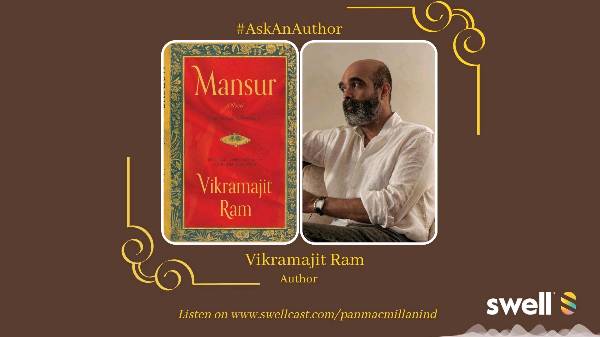
@PanMacmillanInd
This is the official Swellcast of Pan Macmillan India. For more info, please visit: http://panmacmillan.co.in/
Mansur - Author Vikramajit Ram in Conversation.
Art, they say, is a collective memory of society for it expresses how it feels to exist in a particular time and is linked closely to the fundamental sense of self of the artist. Author Vikramajit Ram's novel Mansour dramatizes the life of Ustad Mansour who was an important painter in the court of Mughal and Pera Jahangir. Very little is known about Ustad Mansour's life beyond his exceptional paintings and their associated inscriptions

Vikramajit Ram
@vikramajitram · 0:38
And both art and architectural history have, in some way or the other, shaped and informed almost all of my previous works, both fiction and nonfiction

Vikramajit Ram
@vikramajitram · 1:28
You my very first book. Elephant Kingdom, is a cultural history of the India elephant and was told through depictions of the animal in architectural sculpture. These works of architectural sculpture belong to different periods and different traditions. They include Buddhist, Hindu and Jain architecture, and the time frame spans from the early centuries BC all the way till approximately the 17 hundreds. Now, that book was followed by the first of two travelogues that was dreaming Vishnu's A Journey Through Central India

Vikramajit Ram
@vikramajitram · 2:18
You moving on from nonfiction to fiction, and more specifically, historical fiction, which is an area which really interests me. My first novel, The Sun and Two C's, tells the wholly imagined story of the building of the 13th century Sun Temple of Konak. And what actually drew me to it was one particular panel which I saw way back in the early 2000s while I was researching and photographing elephant, Elephant Kingdom
Now, I don't know for a fact that the dodo in Jahangir's court was immortalized by Mansur's painting, which is considered to be the first color painting of a live dodo. Although many paintings of the bird were done afterwards, very few were done having a live dodo as an object of reference. Even more fascinating is the fact that this painting is now on display at a very unlikely place, a museum in Russia. Could you perhaps connect the dots here for us?

Vikramajit Ram
@vikramajitram · 5:00
And this particular painting dates from approximately 1626 or 1627, which is also the last year of Jahangir's reign. Now there are four other groups of groupings of birds around the central image of the dodo by Mansour, or rather the dodo attributed to Mansour. And those paintings of four different species of birds were done by later hands. Those don't carry an attribution either
Wow. Thank you so much for that. I think there was nothing short of a mini masterclass on ustad Mansur's body of work. So, it is said that Mansur came to maturity as a painter during Jahangir's reign and enjoyed a very privileged status, Which explains why he was mentioned so frequently in Jahangir's memoir. Based on all the research that you've done for the book, could you tell us a little bit more about Ustad Mansur and the role he had under Jahangir's patronage?

Vikramajit Ram
@vikramajitram · 4:27
A short while after The Baba Nama, akbar had commissioned work on the three illustrated volumes of his own life story, the Akbar Nama and 49 of his best miniaturies were kept busy at it in the early 1590s. Of its approximately 115 paintings, two particularly dramatic scenes, one of them of a ceremonial hunt and the other of some prisoners in animal hides, were collaborative works respectively by Mansour and his colleague Misquina and Mansour and Basavan
Thank you so much for sharing that. That was really interesting. Your novel is rich in allusions history semiotics and could be defined as a well constructed labyrinth in meta narrative historical fiction. Could you perhaps share a bit about the research that went behind the writing of Manzur? And I'm also curious to know if you've pretty much stayed loyal to historical events or have you let your creative liberties shape the narrative to a larger extent?

Vikramajit Ram
@vikramajitram · 4:13
And I've certainly taken huge liberties with historical material, with figures and settings to tell this wholly fictional story. And I must say, I've had enormous fun with it
Talking about the paintings referenced to in your novel. Many of them are deeply allegorical. For example, you have reference to a couple of Abu Hassan's paintings, namely Jahangir preferring as Sufi Sheikh and Jahangir embracing Shahbas. Both of these paintings have imagery that draw deep from allegorical sources. And while these portraits are not strictly historically accurate, they represent Jahangir's desired depiction of his rule. Could you elaborate on the allegorical and symbolic representations you've come across in the Mughal art of the period?

Vikramajit Ram
@vikramajitram · 4:15
Certainly not Malikambar or Shahabas, and certainly not King James. Had these wishful allegris been made to remind or even reassure Jangir of his place in the world of kings and men. Do the paintings, then offer a deeper insight into the inner life of their principal subject? So it's these many interpretations they allow that make these paintings quite so compelling

Vikramajit Ram
@vikramajitram · 4:41
I'd say the main distinction between the great masters of the west is that Mughalira painters, especially of Akbar Jahangir and Shah Jahan, were salaried employees working in the highly organized structure of the imperial aclias. And even when they were accompanying their employers on military campaigns and other journeys. Ah. Because their job was primarily to record, illustrate and document, these men were as essential to the day to day running of an empire as were other men in service
Thank you so much, Vikramajit. I've really enjoyed this conversation around your book and all the interesting trivia that you've shared about the art of the period. And as I mentioned earlier, reading the book made me actually look up a lot of the medieval art that came out during the Mughal period, especially months, Zur and his contemporaries. So, yeah, so it did motivate me to delve deeper and try to understand the culture and the art of the period

Vikramajit Ram
@vikramajitram · 0:18
Thank you, Ramya, for reading Mansour and for inviting me to this conversation. It's been an absolute pleasure. I'm especially delighted that you've been looking at Mansour's paintings and the works of his contemporaries. Thank you so much again and more power to you. And Swelcast. Over and out

Sujit Lalwani
@sujitlalwani · 1:29
Thank you. Mr. Victor majid. First of all, congratulations on all the wonderful work you've done. Pleasure to know that there's somebody who can indulge himself into art history, be a writer, reviewer and so much all together at once. And I think that is phenomenal. Looks like it's in the way rains and you've invested tons and tons of time behind all this

Vikramajit Ram
@vikramajitram · 0:34
Ah. Thank you, Sujith, for calling in and leaving me this very kind message. Well, what do I say, other than overwhelmed? And as far as the work itself goes, I guess you could call it an occupational hazard. Anyway, it's good to know that the podcast has been of interest to you. And I hope you get a chance to look at some of the material ram and I spoke about the miniatures, this especially


